
Robohub.org
Robohub Digest 07/15: Competition for Softbank, cake for Engelberger, and robot cookers for consumers
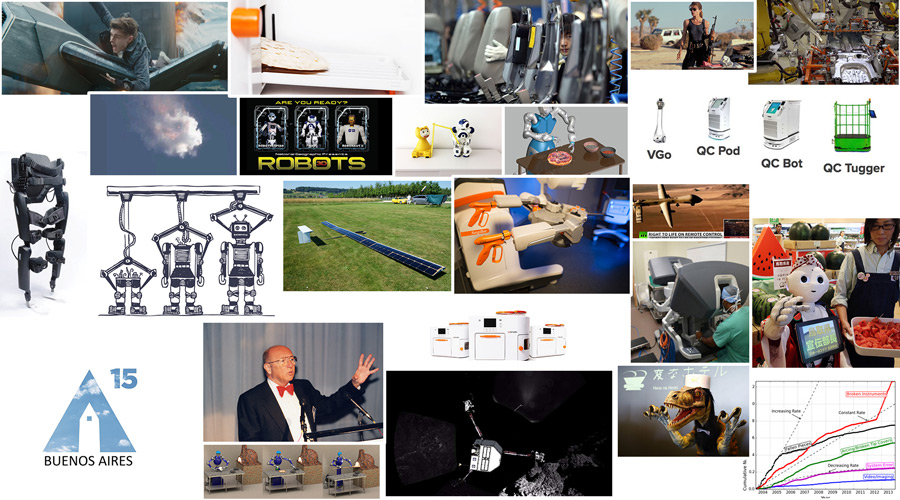
A quick, hassle-free way to stay on top of robotics news , our robotics digest is released on the first Monday of every month. Sign up to get it in your inbox.
A new battle for consumer marketshare is on
First it was Google, Amazon and Apple. Now it’s Japanese telcos that are jockying for position in the robotics game. In early July, SoftBank announced that they will produce and sell 1,000 Pepper robots per month starting August 1. Then, a few weeks later rival Japanese telco NTT launched a competing consumer robot called Sota. Not to be outdone, Softbank responded the next day by announcing they will take preorders for the enterprise version of Pepper starting in October. Both companies will be using the robots to sell data subscription services. Could it be that it’s not just about Google vs Amazon, or Softbank vs NTT anymore, but about telcos vs big data companies? Robohub will be reopening its focus series Big deals: What it means to have the giants investing in robotics to explore how telcos might be changing the game.
At your service
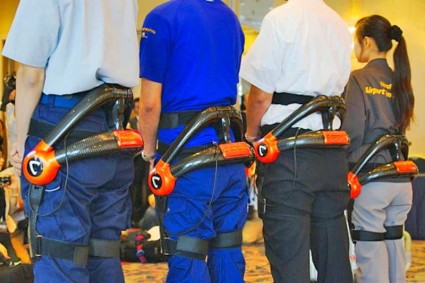
Cyberdyne’s waist-based mini-exoskeleton for airport employees charged with moving and lifting baggage and goods. Source: Getty Images.
Pepper and Sota aren’t the only robots Japanese consumers will be seeing more of soon. Haneda Airport is about to deploy three robots made by Cyberdyne, including an autonomous floor cleaner, a mobile luggage porter and an exoskeleton to help employees handling baggage and goods. And then there is Japan’s new fully robotic Henn na Hotel, which developers hope will change the face of low-cost travel accommodation.
Several market research reports are predicting impressive growth rates for service robotics generally.
Cooking up a storm
But there is more news in service robotics.
This month Robotic flatbread maker Rotimatic (by Zimplistic) received $11.5million from two venture funds. The company took more than $5M in pre-orders of their cooking robot at their launch in 2014 and already has $72M worth of backorders. It seems that robots are back in the popular imagination as household helpers, and investors are taking a bet on leveraging consumer interest in robots as a viable marketing strategy.
But the Rotimatic is not the only cooking robot vying for our attention this month. At the PRISMA lab in Naples, Italy, researchers have chosen to study robotic dynamic manipulation through the task of making pizza (how very Italian!). They hope their RoDyMan robot will provide answers to key problems related to robot gripping.
Major milestones
One of the pioneers of industrial robotics, Joe Engelberger, celebrated his 90th birthday this July. Industrial robotics has come a long way in the sixty years since Engelberger founded Unimation, the world’s first robotics company: Financial Times analysts are now predicting that the payback period for industrial robots with a 10 year life cycle is just 1.7 years in 2015, down from 11.8 yrs in 2008. Meanwhile, Siemens announced a new Robot Launch “Industrial Robotics Award” as part of their Frontier Partner program.
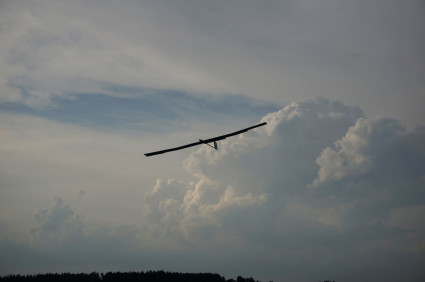
T=81 hours. Thunderstorm clouds and winds up to 60 km/h make landing the AS-2 challenging.
Another major milestone was met when ETH Zurich’s fully solar powered UAV AtlantikSolar achieved a full day/night flight. Then, just two weeks later, they achieved solar powered flight for 81 hours, setting a new endurance world record for UAVs in its class. Demonstrating this kind of endurance has been called the ‘holy grail of perpetual flight’ because overcast skies can inhibit recharging and poor weather or high winds can effect power consumption.
In other news, ReWalk Robotics’s new exoskeleton allowed paraplegic Robert Woo to take a walk on the streets of New York, and the very first robot-aided paediatric surgery was performed at Brooke Army Medical Centre in the US.
Robots making (more) headlines
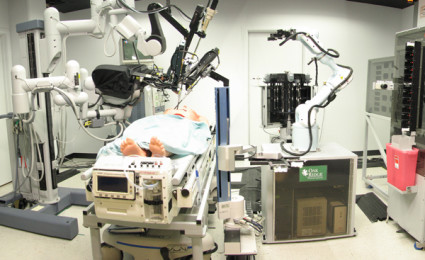
Is the intense focus on safety and effectiveness compromising training opportunities for new robotic surgeons?
A study on adverse events in robotic surgery released this month reported that between January 2000 and December 2013, FDA records showed that robotic surgical procedures were linked to the deaths of 144 people, 1,391 injuries, and involved 8,061 malfunctions – this is out of a total of more than 1.7 million procedures performed in that time period. The report made headlines in mainstream news outlets, including MIT Technology Review. But is the intense focus on safety and effectiveness compromising training opportunities for new robotic surgeons?
 In an unfortunate incident this month, a 21-year-old contractor was killed while installing a robot at a VW assembly plant in Germany when he was accidentally struck in the chest and pinned against a metal plate. The story was tweeted by Financial Times employment reporter Sarah O’Connor, whose name coincidentally shares striking similarities to Sarah Connor, the lead female protagonist in the Terminator movies. In the ensuing hours, O’Connor’s Twitter feed unwittingly received a barrage of Skynet references, the story went viral in the media, and robots got a lot of negative headlines in the process, causing some to question whether the story would have received the same attention had it been labelled as an ‘industrial accident’.
In an unfortunate incident this month, a 21-year-old contractor was killed while installing a robot at a VW assembly plant in Germany when he was accidentally struck in the chest and pinned against a metal plate. The story was tweeted by Financial Times employment reporter Sarah O’Connor, whose name coincidentally shares striking similarities to Sarah Connor, the lead female protagonist in the Terminator movies. In the ensuing hours, O’Connor’s Twitter feed unwittingly received a barrage of Skynet references, the story went viral in the media, and robots got a lot of negative headlines in the process, causing some to question whether the story would have received the same attention had it been labelled as an ‘industrial accident’.
And at the end of July, the IJCAI in Buenos Aires kicked off with an open letter organized by the Boston-based Future of Life Institute (FLI) calling for a ban on offensive autonomous weapons. The letter was signed by over a thousand individuals, including prominent researchers, technologists and thought leaders such as Elon Musk, Stephen Hawking, Steve Wozniak, Erik Brynjolfsson, Eric Horvitz, Geoff Hinton, Yann LeCun, Stuart Russell, and many others. The letter generated headlines across the globe warning of an “AI arms race”, and was celebrated by some as a bold move, but it was taken to task by Automaton’s Evan Ackerman, and criticized as a PR stunt in Pando. Meanwhile, the Future of Life Institute named 37 research teams that will be awarded a share of $7 million from Elon Musk and the Open Philanthropy Project to support research on “keeping AI robust and beneficial”.
Space
In June, Philae made headline news when it woke up after a crash landing that had left it silent for months. But now the lander has gone silent once again. Despite the lack of communication, engineers keep transmitting commands to Philae, in hope that it will continue to carry out measurements and eventually send results back to Earth.
Meanwhile, Elon Musk and his team at SpaceX have been analysing the CRS-7 explosion and have tentatively proposed that a faulty strut may be to blame. Investigations into the incident are ongoing.
The art of the real, and the art of CGI
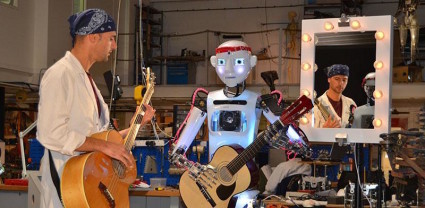
National Geographic’s new movie, Robots 3D, proves that robots don’t need to be sci-fi to be compelling.
We are used to seeing robots with astonishing powers running around on film and TV screens, but National Geographic’s new movie “Robots 3D” is different. It takes us on a tour of real robots in their labs around the world, explaining how far we have really come in the field of humanoid robotics without the need for special effects. We were impressed!
But if you’re into deconstructing sci-fi, check out this article by special effects expert Graham Edwards, who explains – from script writing and robot design to filming and post production – what goes into making the robots in movies like “Robot Overlords” look so real.
Enjoy the digest? Don’t miss the next issue! Sign up to get it in your inbox every month.
Upcoming robotics events
- Robotronica – Brisbane QLD, Australia – August 23, 2015
- TRADR Summer School on Autonomous Micro Aerial Vehicles – Sankt Augustin, Germany – August 24-28, 2015
- IEEE Intl Conf on Automation Science and Engineering (CASE) – Gothenburg, Sweden – August 24-28, 2015
- IEEE Ro-Man Socially Embedded Robots Conference – Kobe, Hyogo Prefecture, Japan – August 31 – September 4, 2015
- IFA 2015 Consumer Trade Show – Messe Berlin, Germany – September 4-9, 2015
tags: Robohub Digest







